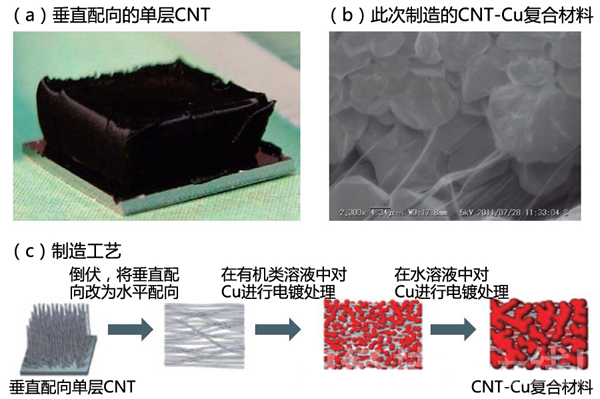Composite material of CNT and copper achieves 100 times the current of the copper wire
The Japan Industrial Technology Research Institute (hereinafter referred to as “Production Research Instituteâ€) has developed a new material that achieves the same electrical conductivity as copper by combining single-walled carbon nanotubes (CNTs) and copper (Cu). Copper 100 times the current capacity (also called the maximum current density). According to the Institute, this CNT-Cu composite material can not only be used for high current, but also light weight and high temperature resistance, so it can be used as a wiring material for ultra-small high-performance semiconductor chips.
So far, the overall layout of the semiconductor chip and the wiring material between the chips generally use metals such as copper, aluminum (Al), and gold (Au) ( FIG. 1 ). However, although the conductivity of these metals is high, the current carrying capacity is not necessarily large. When a high voltage above a certain value is applied, this voltage will cause the atomic structure to collapse, which will cause a sharp increase in the resistance and eventually cause the wire to break.

Fig. 1 The use of CNTs and Cu for the "reinforced concrete" breakthrough obstacle
In terms of conductivity and current carrying capacity, the new material combines the high current carrying capacity of CNTs and the high conductivity of Cu (a). Previously, people did not find materials with both high current carrying capacity and high electrical conductivity. The CNT-Cu composite material also achieved two characteristics (b).
From the aspect of use, as the miniaturization technology advances, the current-carrying capacity required for the wiring of semiconductor chips and the like also gradually increases. Production Research Institute stated that by 2015, the required ampacity will reach 1 million (106) A/cm2 that Cu and Au cannot achieve.
CNTs and graphene and other "nano-carbon materials" have a current carrying capacity of about 1 billion (109) A/cm2. This is because of the strong coupling ability between carbon atoms, even if a high voltage is applied, it is difficult to cause the collapse of the atomic structure. However, the conductivity of this material is less than 1/100 of Cu and Au. Previously, researchers have not found a material with a current carrying capacity equal to that of CNTs and a conductivity equivalent to that of Cu.
CNT can inhibit the diffusion of Cu
The CNT-Cu composite material is composed of CNT and Cu, and the above two characteristics are realized for the first time. Its current carrying capacity is 6.3 x 108A/cm2, which is about 100 times that of Cu.

Figure 2 Conductivity is not easy to reduce at high temperatures
Change of Conductivity of CNT - Cu Composites and Cu at Different Temperatures . Compared with Cu, CNT-Cu composites have a smaller temperature-induced conductivity change. (Figure: Production Research Institute)
Production Research Institute said that the reason why new materials can obtain such a high ampacity is because CNT can inhibit the diffusion of Cu. In this CNT-Cu composite material, CNT and Cu form a structure like "iron reinforced concrete", and CNT plays a role in enhancing the "strength" of Cu under high voltage.
At room temperature, the electrical conductivity of this composite is comparable to that of Cu. However, even at high temperatures around 200°C, the conductivity of the new material does not decrease significantly, which is even better than Cu (Figure 2).
According to the introduction of the Institute of Advanced Manufacturing Technology, the new material manufacturing process basically involves electroplating CNTs in solutions containing Cu ions (Fig. 3). The key point is that the CNTs are slowly electroplated in an organic solution at a current density of 1 to 5 mA/cm<2 > instead of being quickly plated in an aqueous solution. In this way, Cu can be filled inside the CNT structure.

Figure 3 Manufactured using a solution process
Overview of the manufacturing process of CNT-Cu composites. After the horizontally aligned single-layer CNTs developed by Japan Research Institute and Japan Rayon were horizontally aligned, they were sequentially prepared by copper plating in organic solutions and aqueous solutions. (Figure: Production Research Institute)
There are currently more than 1,000 times the price gap
The biggest problem with this composite is that the cost of single-layer CNTs is still high. The cost of single-layer CNTs is currently 1,000 yen to 10,000 yen/g (depending on the purity), which is similar to that of Au about 4300 yen/g. However, the cost of Cu is only about 0.76 yen/g, and there is a huge price gap between single-layer CNTs.
In the production of single-layer CNTs, Zyntek has used the "Super Growth" method jointly developed by the Institute and Japanese companies such as Rayon, which is a process for producing high-purity single-layer CNTs. Zeon plans to mass-produce single-layer CNTs using the rapid growth method from 2015. In the future, it is possible to reduce manufacturing costs to around 10 yen/g.
Production Research Institute said that in the future, it will jointly develop new materials with the manufacturer's specific uses, and promote the practical application. (Reporter: Nozawa Tetsuru, Nikkei Electronics)
Portable Water Heater ,Forced Exhaust Gas Water Heater,Gas Water Tankless Gas Geyser Manufacturers and Suppliers in China
Portable WATER HEATER ,FORCED EXHAUST GAS WATER HEATER,Gas Water Tankless Gas Geyser,Forced Exhaust Portable Gas Water Heate
This kind of goods,we will use best quality for our own cusotmers ,keep good price for them as well .
China Portable Water Heater ,Forced Exhaust Gas Water Heater ,Gas Water Tankless Gas Geyser,Forced Exhaust Portable Gas Water Heate, we offered that you can trust. Welcome to do business with us.
FORCED EXHAUST GAS WATER HEATER
Portable Water Heater,Forced Exhaust Gas Water Heater,Gas Water Tankless Gas Geyser,Forced Exhaust Portable Gas Water Heate
GUANGZHOU AIJINGSI TRADING LIMITED , http://www.aichugashob.com